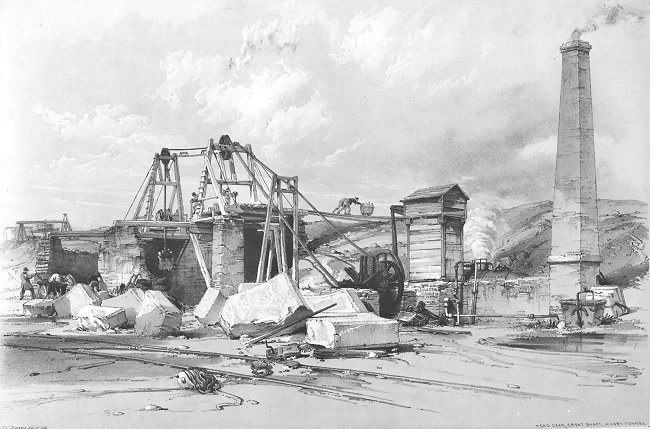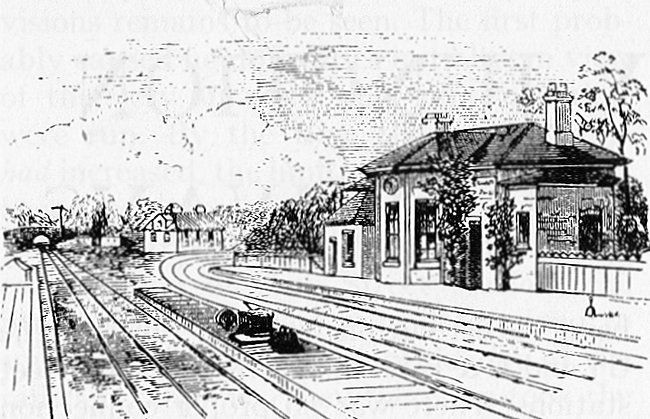Part 1 Part
2 Part 3 (this page)

This is Tring Cutting during excavation. The teams digging the cutting used shovels to put the spoil into wheelbarrows. Planks were laid up the cutting sides for the wheelbarrows to run up, aided by a rope connected to a horse that provided the power. At the top of the cutting the wheelbarrow was emptied. The date is 17th June 1837.

Using explosives to blast lineside boulders at Linslade.

The bridge at Denbeigh Hall, Bletchley. Trains terminated here
temporarily while Kilsby Tunnel was under construction, and the
passengers continued their journeys by stage coach.

Wolverton Viaduct nearing the end of its construction. The rounded
wooden frameworks that supported the bricks forming the arches as they
were laid can be seen on the left.

Horse-assisted wheelbarrows in use at Boxmoor on 11th June 1837. The horse walked along the top of the cutting and had a rope attached to it that ran round a
pulley and down to the wheelbarrow that was directed up the ramp by a man.

The curved cutting at Blisworth. Note the wooden baulks holding up the unstable lumps of rock in the left foreground. The policeman has just flagged the train past. He is wearing a great coat and a top hat.

A different view of Blisworth. The scene is a little round the curve
from the previous one.

A steam powered winder above Kilsby Tunnel. On the right is the chimney - presumably the boiler is out of sight somewhere at the base of it. The beam engine is half in and half out of the engine house. The rocking beam drives a "sun and star" gear that drives a winder, which is connected over pulleys to the shaft head. A man is hand pushing a wagon loaded with spoil to the tipping area. On the left is a horse gin.

The surface area above Kilsby Tunnel. In the right foreground is a shaft down which there is a water pump, to keep the workings clear.
A set of rocking rods connects the beam engine in the distance to the pump. There is a second beam engine house in the distance, both having adjacent chimneys associated with their boilers. Also in the view are three horse gins, where the horse walks round in a circle all day and turns the winding mechanism for raising and lowering wagon loads of spoil.

The Great Shaft of Kilsby Tunnel. You know when you pass this point when travelling on a modern train because the pressure in your ears momentarily reduces.
The tunnel is 2,400 yards long. It must have been a phenomenal experience for Mr Bourne to walk through the tunnel while it was being constructed.

The inside of Kilsby Tunnel, which is south of Rugby, on 8th July 1837. This image shows a loaded railway wagon being winched up a ventilation shaft, so that the spoil can be dumped. A man can just be seen riding on the spoil wagon.
The tunnel diggers encountered a number of problems, including quicksand
and frequent flooding of the workings.

Hampton-in-Arden station is between Coventry and Birmingham. The
London & Birmingham Railway is on the left of this scene and runs
under the bridge to Birmingham.
On
the right is the Birmingham & Derby Junction Railway (BDJR).
Trains from Euston to Derby left the London & Birmingham Railway
at this point and ran round the curve in the picture to Whitacre Junction,
where they joined the Birmingham to Derby line. This arrangement was
superseded when the Midland Railway (successors to the BDJR) built their
own London Extension to St Pancras, temporarily running into Kings Cross
until their own line and the magnificent Barlow roof at St Pancras were
completed.

The northern terminus of the London and Birmingham Railway was Curzon
Street Station in Birmingham. This is the imposing entrance to the
station in 1840. The station also acted as
terminus for the Grand Junction Railway so acting as a link in the
railway from London to Liverpool and Manchester.

Another view of the Curzon Street building. Some sources refer to
this as the station building, while other refer to it as the Curzon
Street Hotel. Perhaps it served both functions.

The locomotives of the London and Birmingham Railway needed a
locomotive depot at the Birmingham terminus. This served to turn the
engines around, supply them with water, supply them with coal and carry
out maintenance.
Part 1 Part
2 Part 3 (this page)
|
















